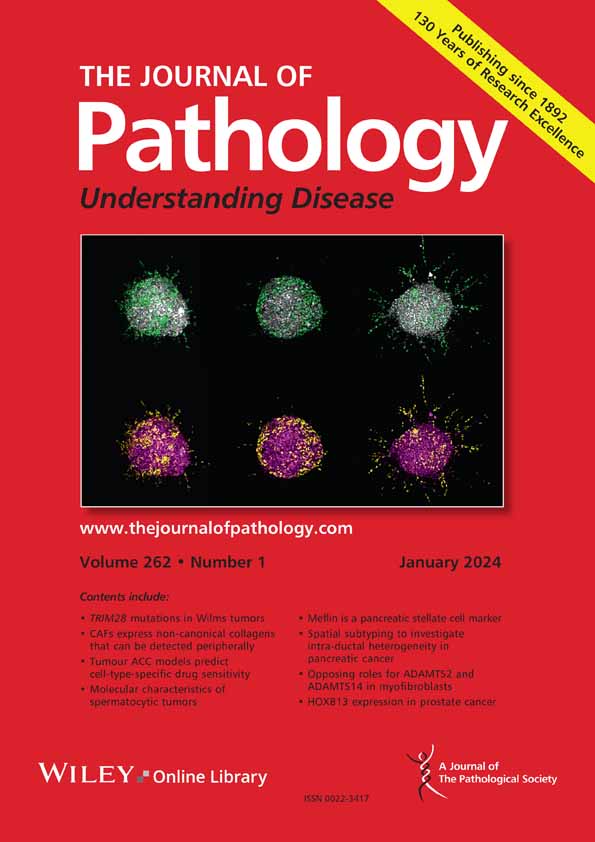Larissa E Vlaming-van Eijk, Zarlasht Sarsam, Janna Bakker, Marjan Reinders-Luinge, Corry-Anke Brandsma, Wim Timens
求助PDF
{"title":"SARS-CoV-2进入相关蛋白在COPD气道中的表达:一项免疫组织化学研究","authors":"Larissa E Vlaming-van Eijk, Zarlasht Sarsam, Janna Bakker, Marjan Reinders-Luinge, Corry-Anke Brandsma, Wim Timens","doi":"10.1002/path.6477","DOIUrl":null,"url":null,"abstract":"<p><p>Coronavirus disease 2019 (COVID-19) is of special concern to patients with chronic obstructive pulmonary disease (COPD), given their susceptibility to exacerbations caused by respiratory tract infections. As the susceptibility of acquiring a SARS-CoV-2 infection in COPD remains unclear, this study explored the airway expression of SARS-CoV-2 entry-associated proteins in the lungs of COPD patients in comparison to non-COPD controls. Immunohistochemical staining of lung tissue was performed to investigate the expression profiles of SARS-CoV-2 entry-associated proteins in the bronchial epithelium of 27 COPD patients and 40 non-COPD controls. In addition, the associations between these expression profiles with lung function in COPD patients and smoking status in non-COPD controls were examined. COPD patients demonstrated smoking-independent lower expression of HSPA5, NRP1, BSG, TMPRSS2, and ITGB6 in airway epithelium as compared to non-COPD controls. No significant differences were observed for Furin, CTSL, ADAM17, and ITGA5. BSG percentage area expression was significantly negatively associated with lung function in COPD patients. Moreover, the study revealed smoking-associated differences for Furin, HSPA5, ADAM17, BSG, ITGA5, and ITGB6 within non-COPD controls, with lower airway epithelial expression (except for Furin) in ever-smokers than in never-smokers. To conclude, this study showed a lower expression of a specific set of SARS-CoV-2 entry-associated proteins in the bronchial epithelium of COPD patients compared with non-COPD controls, while other factors showed similar expression levels. The consequences of these findings on COVID-19 susceptibility remain uncertain. Although reduced expression of entry factors may suggest less cellular availability for viral entry, it could be speculated that the similar expression levels of other factors, together with impaired airway clearance in COPD, may still facilitate infection, thereby providing potential mechanistic insight into COVID-19 susceptibility in this patient population. © 2025 The Author(s). The Journal of Pathology published by John Wiley & Sons Ltd on behalf of The Pathological Society of Great Britain and Ireland.</p>","PeriodicalId":232,"journal":{"name":"The Journal of Pathology","volume":" ","pages":""},"PeriodicalIF":5.2000,"publicationDate":"2025-10-06","publicationTypes":"Journal Article","fieldsOfStudy":null,"isOpenAccess":false,"openAccessPdf":"","citationCount":"0","resultStr":"{\"title\":\"Expression of SARS-CoV-2 entry-associated proteins in COPD airways: an immunohistochemical study.\",\"authors\":\"Larissa E Vlaming-van Eijk, Zarlasht Sarsam, Janna Bakker, Marjan Reinders-Luinge, Corry-Anke Brandsma, Wim Timens\",\"doi\":\"10.1002/path.6477\",\"DOIUrl\":null,\"url\":null,\"abstract\":\"<p><p>Coronavirus disease 2019 (COVID-19) is of special concern to patients with chronic obstructive pulmonary disease (COPD), given their susceptibility to exacerbations caused by respiratory tract infections. As the susceptibility of acquiring a SARS-CoV-2 infection in COPD remains unclear, this study explored the airway expression of SARS-CoV-2 entry-associated proteins in the lungs of COPD patients in comparison to non-COPD controls. Immunohistochemical staining of lung tissue was performed to investigate the expression profiles of SARS-CoV-2 entry-associated proteins in the bronchial epithelium of 27 COPD patients and 40 non-COPD controls. In addition, the associations between these expression profiles with lung function in COPD patients and smoking status in non-COPD controls were examined. COPD patients demonstrated smoking-independent lower expression of HSPA5, NRP1, BSG, TMPRSS2, and ITGB6 in airway epithelium as compared to non-COPD controls. No significant differences were observed for Furin, CTSL, ADAM17, and ITGA5. BSG percentage area expression was significantly negatively associated with lung function in COPD patients. Moreover, the study revealed smoking-associated differences for Furin, HSPA5, ADAM17, BSG, ITGA5, and ITGB6 within non-COPD controls, with lower airway epithelial expression (except for Furin) in ever-smokers than in never-smokers. To conclude, this study showed a lower expression of a specific set of SARS-CoV-2 entry-associated proteins in the bronchial epithelium of COPD patients compared with non-COPD controls, while other factors showed similar expression levels. The consequences of these findings on COVID-19 susceptibility remain uncertain. Although reduced expression of entry factors may suggest less cellular availability for viral entry, it could be speculated that the similar expression levels of other factors, together with impaired airway clearance in COPD, may still facilitate infection, thereby providing potential mechanistic insight into COVID-19 susceptibility in this patient population. © 2025 The Author(s). The Journal of Pathology published by John Wiley & Sons Ltd on behalf of The Pathological Society of Great Britain and Ireland.</p>\",\"PeriodicalId\":232,\"journal\":{\"name\":\"The Journal of Pathology\",\"volume\":\" \",\"pages\":\"\"},\"PeriodicalIF\":5.2000,\"publicationDate\":\"2025-10-06\",\"publicationTypes\":\"Journal Article\",\"fieldsOfStudy\":null,\"isOpenAccess\":false,\"openAccessPdf\":\"\",\"citationCount\":\"0\",\"resultStr\":null,\"platform\":\"Semanticscholar\",\"paperid\":null,\"PeriodicalName\":\"The Journal of Pathology\",\"FirstCategoryId\":\"3\",\"ListUrlMain\":\"https://doi.org/10.1002/path.6477\",\"RegionNum\":2,\"RegionCategory\":\"医学\",\"ArticlePicture\":[],\"TitleCN\":null,\"AbstractTextCN\":null,\"PMCID\":null,\"EPubDate\":\"\",\"PubModel\":\"\",\"JCR\":\"Q1\",\"JCRName\":\"ONCOLOGY\",\"Score\":null,\"Total\":0}","platform":"Semanticscholar","paperid":null,"PeriodicalName":"The Journal of Pathology","FirstCategoryId":"3","ListUrlMain":"https://doi.org/10.1002/path.6477","RegionNum":2,"RegionCategory":"医学","ArticlePicture":[],"TitleCN":null,"AbstractTextCN":null,"PMCID":null,"EPubDate":"","PubModel":"","JCR":"Q1","JCRName":"ONCOLOGY","Score":null,"Total":0}
引用次数: 0
引用
批量引用

 求助内容:
求助内容: 应助结果提醒方式:
应助结果提醒方式:


